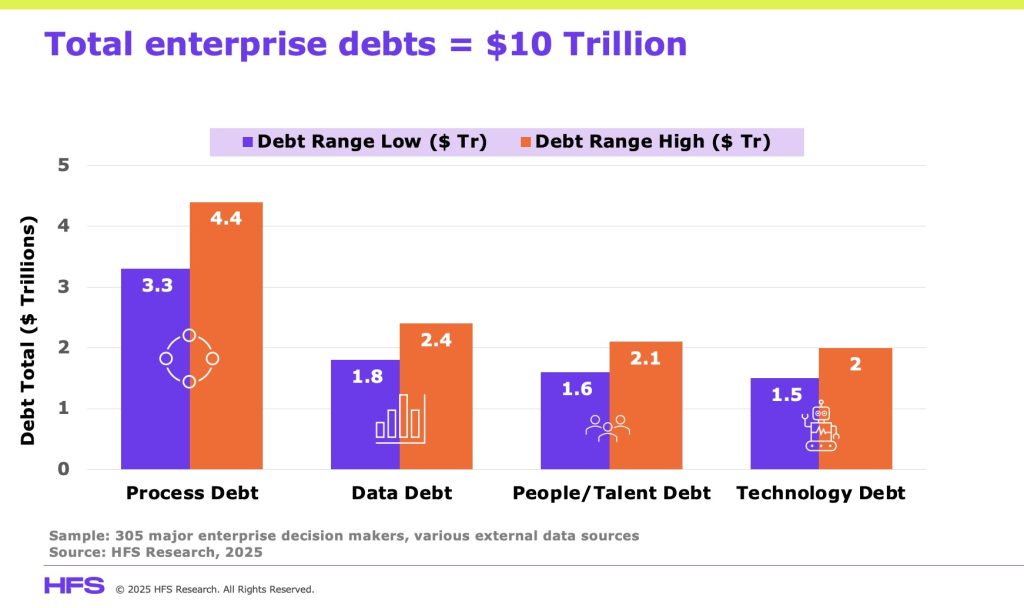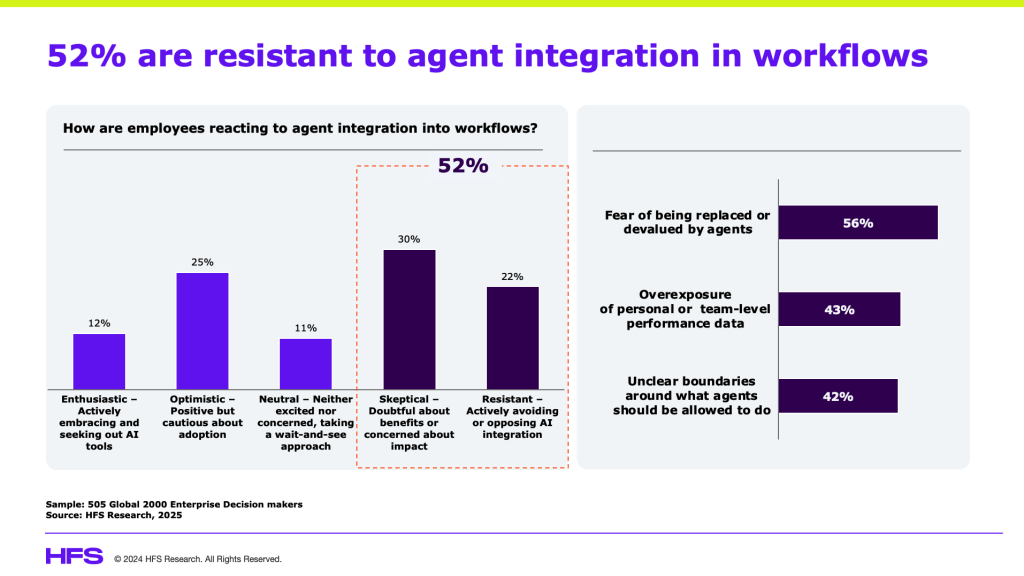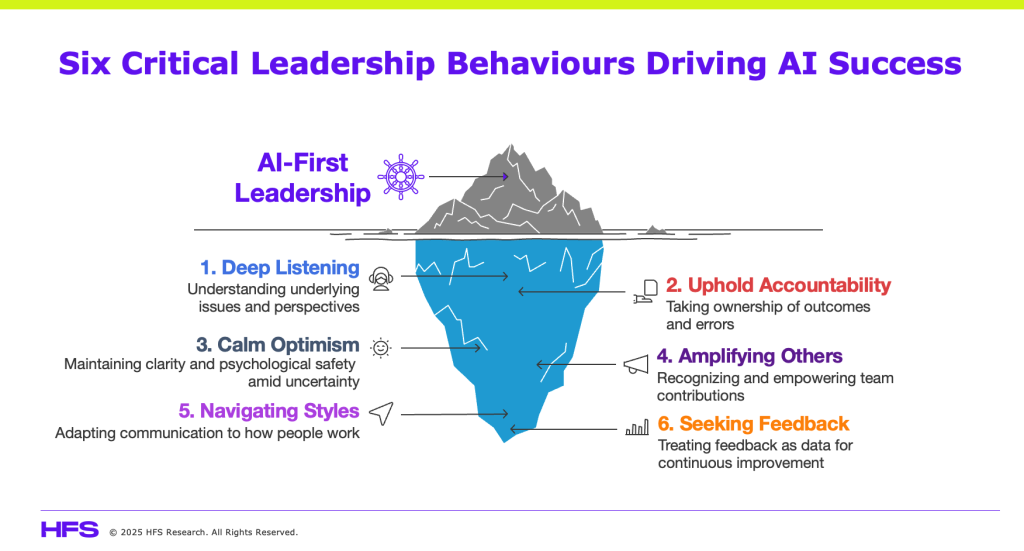Enterprises are running faster than their leaders can evolve. Boards demand AI-powered growth, while employees crave purpose and job stability. Customers expect personalization and ethics in the same breath, while investors want returns yesterday. Caught in the middle, leaders are overpromised on technology and underdeveloped on humanity. That gap is what we term leadership debt, and it’s the most expensive liability no CFO can measure.
HFS estimates that today’s Global 2000 enterprises carry close to $10 trillion in combined debt across process, data, people, and technology. Yet none of these debts compound faster or cut deeper than leadership debt. It sits inside the people debt, amplifying its impact across every transformation layer. Leadership debt is the gap between what leaders expect from AI-driven change and how they actually lead through it. It is the interest paid on avoidance, inconsistency, and unearned optimism.

Leadership debt explains why so many enterprises are “AI-ready” on paper but emotionally unprepared in practice. The systems are there, but the trust is not. The dashboards light up, but the teams shut down. This debt shows up as friction in decision-making, fear in the culture, and a widening gap between what organizations say they value and how they behave under pressure.
Fear isn’t the problem. Leadership avoidance is
Executives keep saying their people are afraid of AI. They are not wrong, but they are not right either. Fear in the workforce is not resistance; it is feedback. It signals that leaders have moved faster than their people’s sense of purpose, security, or control.
HFS research shows that 52 percent of employees are either skeptical or resistant to AI agent integration in their workflows, with the top concern being a fear of replacement or devaluation. This is not an irrational fear; it is a rational response to unclear leadership.

Most leaders talk about the promise of AI, not its consequences. They announce automation but rarely explain adaptation. They celebrate efficiency but skip over impact. Fear spreads not because employees misunderstand AI, but because leaders fail to explain what it means for them, then blame them for reacting to uncertainty.
Recognizing fear is not enough. Leadership accountability means closing the gap between intent and impact. It means listening to what the workforce is afraid of and responding with clarity, not platitudes. Until leaders take ownership of that, AI adoption will remain an exercise in anxiety management, not transformation.
The critical six leadership behaviors to succeed in the AI age
The pattern across every successful AI transformation is consistent. Effective leaders in today’s ambitious AI-first organizations practice six behaviors relentlessly. These behaviours are much more than mere soft skills, they are the leadership operating system that determines whether your AI investments deliver returns or stall in resistance.

- Deep Listening
A global pharmaceutical company’s AI forecasts were off by double digits for months despite multiple rounds of model tuning. The problem was not technical; it was human. Field teams had noticed errors but stopped reporting them because their VP dominated every meeting and dismissed new ideas. When a new COO replaced the routine updates with one question, “What are we missing?”, the issue surfaced within days. Packaging suppliers had changed barcode formats, and the model had never been retrained to recognize them. The fix took 48 hours. Most executives would have launched another task force. She simply listened.
HFS’s extensive research with its OneCouncil members finds that firms with strong listening cultures make decisions significantly faster and with higher accuracy. The World Economic Forum ranks active listening among the top five skills for future leaders. Listening is not empathy theater; it is operational intelligence.
Leaders should begin meetings with “Tell me what I don’t know,” hold regular skip-level sessions, and limit their own talk time in problem-solving discussions. When front-line input drives process improvements each quarter, leaders are truly hearing what matters.
- Uphold accountability
When an AI triage system misrouted urgent healthcare cases, one executive issued a direct internal message: “I approved this rollout too fast. Here’s what we’re fixing and how we’ll prevent it next time.” Trust rose immediately. Leaders who hide behind vendors or processes see repeat incidents climb. Those who take ownership see faster recoveries and stronger team confidence.
Accountability is not a communication tactic; it is the leadership signal employees read aloud. A simple three-sentence “Own It” framework works best: what happened, what I own, and what we will do next. When issues are acknowledged within 24 hours, teams respond faster and alignment returns quickly.
- Model calm optimism
During an AI pilot kickoff, a CIO began with a moment of humor. “I asked ChatGPT to write this speech. It gave me 1,200 words of nonsense. Let’s learn together how to make it useful.” The laughter that followed broke the tension and unlocked genuine curiosity across the team. Leaders who admit uncertainty create psychological safety. Those who fake confidence lose talent. LinkedIn data reinforces that nearly nine in ten employees value trust in leadership over compensation.
Calm optimism is not naïve cheerfulness. It is clarity in uncertainty. The best leaders use a simple rhythm: here is what we know, here is what we do not know yet, and here is what we are trying next. When teams feel honesty, they stay engaged through change rather than fearing it.
- Amplify others
A global bank’s CTO cut loan approval times by 60 percent and chose not to take the stage alone. At the next town hall, he invited the data engineer, compliance officer, and operations lead who built the solution to share how they did it. Collaboration between departments rose immediately.
Leadership amplification changes behavior faster than any governance rule. When people see peers recognized for cross-functional success, they start sharing data and expertise without being told.
- Navigate styles for simplified communication
One VP of Operations created a one-page communication guide for her leadership team, listing preferred timing, channel, and decision style for each executive. She redesigned meetings to close with one decision, one owner, and one deadline. Average meeting length dropped dramatically. Most organizations do the opposite. They invite more people, skip agendas, and leave without clarity. The cost shows up in lost time, rework, and frustration.
Leaders who match their communication to how people work spend less time in meetings and more time moving forward. Every meeting that ends without a clear outcome adds interest to your leadership debt.
- Seek feedback
A CFO ends each quarter with a reverse review, asking her team to rate her on clarity, speed, and decision quality. The first session was uncomfortable. By the third, it was transformational. By treating feedback as data, she created a continuous learning loop.
The World Economic Forum lists continuous learning and feedback literacy among the top three skills for 2025. LinkedIn’s research shows that 91 percent of employers now rank human skills as equal or greater in importance to technical expertise, yet fewer than 20 percent measure them. Asking for feedback is not weakness; it is model retraining for humans.
Bottom line: leadership is no longer about “soft skills”, but a systemic human upgrade to how we lead and drive teams
You can buy technology, restructure processes, and outsource data cleanup, but you cannot automate human maturity. Paying down leadership debt begins with six repeatable behaviors: hear deeply, uphold accountability, model calm optimism, amplify others, navigate styles and simplify, and seek feedback as fuel. These are not soft skills. They are the hard human system upgrades that determine whether AI investments create value.
The leaders who win the AI era will not be those who master neural networks. They will be the ones who master themselves. Leadership is not a byproduct of transformation. It is the precondition for it. The AI economy will be led by humans at the helm.
Posted in : Agentic AI, AGI, Artificial Intelligence, Automation, Employee Experience, Leadership





